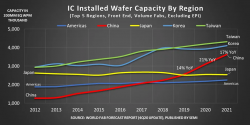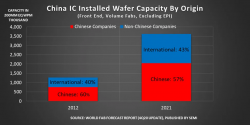You can compare Huawei and ZTE to gain inside to their mindsets,
Huawei is acting now because it got fully sanctioned and has no choice albeit a bit too late . Now it forming its fabs , getting into semiconductor manufacturing process development and supporting research institutes.
On the other hand, ZTE thinks it home free now after paying US $1billion USD fine. So it continue to do the old style, designing its own chip and fab out to TSMC. I have not heard any news that ZTE is actively doing things that Huawei is currently doing.
...
I wouldn't say that. ZTE originally didn't even design their own chips I think. But now they do. Plus now that they have US spies on their corporate board thanks to the deal there's probably a lot of things they don't even try to do that they would otherwise. Long term capital intensive projects like fab construction could be easily torpedoed and put the company in a really bad financial situation.
Well at least for memory the initial production was really low. But with the coming into market of foreign fabs like Intel's and Hynix's and now home grown YMTC and CXMT a lot more capacity was brought in. 95% growth isn't impressive when you start from near zero.
What is impressive is that according to their data China has already surpassed both Japan and the USA in 200mm wafer per month equivalents and is quite close to South Korea (#2) and Taiwan (#1) which are basically neck and neck. So this means by 2025 it is quite likely China will be #1 in production capacity. Just look at those slopes.

the majority is in the hands of foreign companies
Yes like Hynix in the case of memory. In the foundry market there is a presence in China of companies like UMC and TSMC. But that is not a bad thing. It is better than importing it all from abroad. Even those companies will create a cadre of Chinese professionals to operate the plants and local suppliers for consumables I bet. That will drive down costs and improve the ecosystem in China for everyone else too.
Also in the long term the numbers will change. Just look at this chart from the earlier article.

Most of the installed wafer capacity is in fact Chinese. The problem is likely that Chinese factories thus far achieve lower effective production and factory usage rate because of less mature production skills.
The semiconductor portion of MIC2025 was always aspirational.
Which brings us to this point. To achieve the ambitious targets of MIC2025 by that short timeline was never going to be possible without foreign plants and chip designs driving much of the growth together with home grown native growth.
I’d call it a success if they can completely domesticate DUV and dominate global market for >7nm from 2025 onwards
7nm-14nm technology can keep things running for a long time.
Well I wouldn't. That would mean that leading edge products, where most of the profit in consumer electronics is, will be out of reach for the Chinese electronics sector. The US could easily torpedo all Chinese high end smartphone production for example. Entry into new markets like gaming consoles would also never happen if the US was against it. Sure it will be fine for smart TVs, cars, and much of the market but it will reduce the scope of the Chinese semiconductor market way too much.
The only way to solve this is with investments in the tools sector. I have been saying this here since before Huawei was sanctioned.


